The Changing Orbit
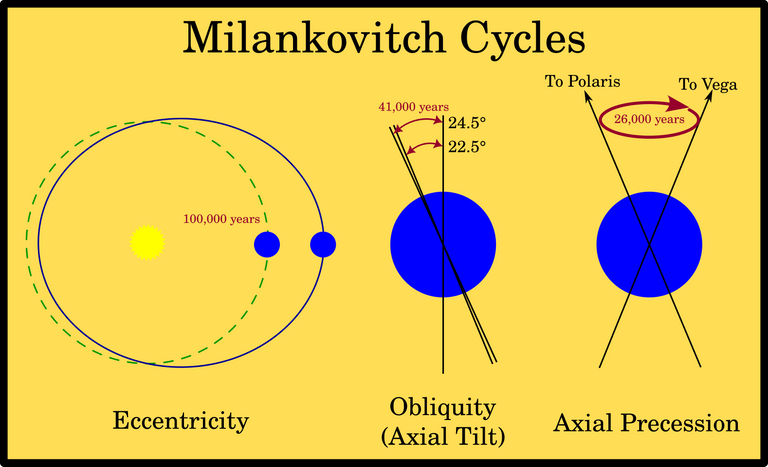
Chapter VIII of Immanuel Velikovsky’s Earth in Upheaval is called Poles Displaced. In this chapter Velikovsky explores a number of possible causes of ice ages. Central to these hypotheses is the concept of a pole shift, which could explain why the Arctic ice cap during the Pleistocene Ice Age was not symmetrically arranged around the current North Pole: significant parts of Alaska and Eastern Siberia remained unglaciated, while Ireland, Britain and New York were buried beneath thick sheets of ice.
The fourth section of this chapter, The Changing Orbit, is the shortest and briefly explores the possibility that the climatic changes associated with ice ages are caused by alterations in the Earth’s orbit about the Sun. Today this is the preferred explanation of ice ages. Its modern form is the theory of Milankovitch Cycles, first developed in the 1920s by the Serbian astronomer Milutin Milanković. In addition to changes in the Earth’s orbit, Milanković’s model also attempts to explain climate change in terms of secular alterations in the Earth’s axis.
In its early years Milanković’s hypothesis received support from Wladimir Köppen and Alfred Wegener, two of the leading proponents of Continental Drift. It was also at the urging of these scholars that Milanković investigated the possibility that secular changes in the position of the Earth’s pole—true polar wander—could account for anomalous findings, such as the glaciation of tropical regions or the occurrence of large coal deposits in Svalbard.

Like Wegener, Milanković had to wait many decades before his theories on the climatic effects of secular changes in the Earth’s orbit were finally accepted by mainstream scientists.
Velikovsky begins his discussion with some background information:
At present the elliptical form of the orbit changes by a very small amount. This could be the residue of a displacement the earth suffered on its path; but following the principle of Laplace and Lagrange concerning the stability of the planetary system, this variation in the shape of the terrestrial orbit is considered to be an oscillation, the mean shape of the orbit being regarded as fixed. The period of this oscillation is supposed to be of very long duration.
The obliquity of the ecliptic, or the angle which the plane of the equator makes with the plane of the earth’s orbit, is 23½°; this obliquity causes the sequence of the seasons. It changes now at the rate of 0.47" a year, “but the limits of its variation are difficult to calculate.” The figures offered by various mathematicians differ greatly. Lagrange estimated the angle of the swing to be as large as 7° with a period that had its last maximum in the year 2167 before the present era; Stockwell calculated the angle of oscillation at less than 3°; while Drayson estimated that the obliquity ranged from 35° to 11°, that is, a swing of 24°. (Velikovsky 112)
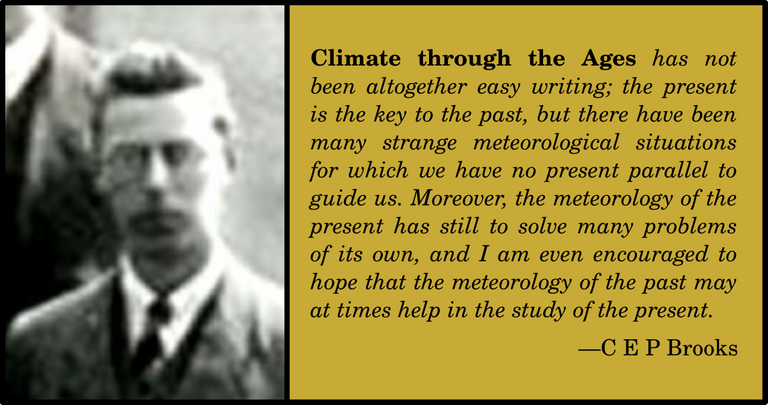
The quotations are taken from Climate through the Ages by Charles Ernest Pelham Brooks, a work that Velikovsky first cited in Chapter IV in connection with the discovery of corals in the Polar regions. Brooks was a civil servant who worked at the British Meteorological Office for over forty years. He is best remembered for his classic text Climate through the Ages, which was first published in 1926. Velikovsky cites the Second Edition of 1949.
Velikovsky’s quotation is taken from Chapter V, Astronomical Factors of Climate:
The radiation emitted from the sun is not the only factor in determining the solar climate of the earth. Whether or not the total heat received by the earth in the course of a year has remained constant, its distribution among the belts of latitude during the different months has certainly varied from time to time, and this distribution can be calculated. There are three variables to be considered in this respect. The first is the obliquity of the ecliptic, or the angle which the plane of the equator makes with the plane of the earth’s orbit round the sun. It is this which causes the seasons; the greater the obliquity of the ecliptic the greater is the contrast between the heat received in summer and that received in winter. In 1910 the obliquity was 23° 27' 3.58", and it was decreasing at the rate of 0.47" a year, but the limits of its variation are difficult to calculate. Lagrange found a maximum of 27° 48' in 29,958 B.C., a minimum of 20° 44' in 14,917 B.C., and a maximum of 23° 53' in 2167 B.C. J. N. Stockwell gives much narrower limits, ranging from 24° 36' to 21° 59', with a maximum of 24° 17' in 8150 B.C., since when there has been a steady decrease. Drayson, on the basis of a theory not accepted by the majority of astronomers, supposed the obliquity to range from 35° to 11°, the period being 31,680 years. The latest work by M. Milankovitch [Milankovitch 1920] assumes a variation between 22° and 24½° in a period of 40,400 years. (Brooks 102)

Velikovsky mentions again the possibility that such changes may be a relic of some past catastrophe, but concedes that a gradualist explanation is generally assumed to lie at its root:
This variation, whatever its numerical value, could have been caused by a disturbance which the earth suffered; but again, the cause being unidentified, the effect is considered to be a permanent oscillation. (Velikovsky 112)
Brooks next considers two other astronomical factors: the eccentricity of the Earth’s orbit, and the precession of the equinoxes. The first of these refers to the amount by which the Earth’s elliptical orbit deviates from perfect circularity. The second refers to the wobbling of the Earth about its axis much like a child’s spinning top, so that the point in the sky to which the axis points—currently occupied by the Pole Star, Polaris—changes slowly over time:
The second variable is the eccentricity of the earth’s orbit. This orbit is elliptical, with the sun at one of the foci, and the distance between the centre of the ellipse and this focus, expressed in terms of the major axis of the ellipse, is termed the eccentricity. It varies in a period of about 100,000 years from zero to a value of about 0.07. When the earth is nearest to the sun it is in perihelion, when most distant, in aphelion. At perihelion the earth travels along its orbit more rapidly than at aphelion. Thus the season which coincides with perihelion will be short and relatively warm, that which coincides with aphelion will be long and relatively cold, but the total amount of heat received on each hemisphere in the course of a year will be the same. At present, the Northern Hemisphere has its winter in perihelion and its summer in aphelion; with the Southern Hemisphere, of course, the reverse is the case. Hence the solar climate of the Northern Hemisphere is less extreme than that of the Southern Hemisphere; the fact that, actually, the climate is much more extreme in the Northern Hemisphere is due to the preponderance of land there. The season in which perihelion falls is not constant but undergoes a cyclic variation with a period of 21,000 years. Thus 10,500 years ago the Northern Hemisphere had its winter in aphelion and its summer in perihelion, consequently a more extreme solar climate. This regular variation is termed the precession of the equinoxes; it is the third of our astronomical variables. (Brooks 102-103)
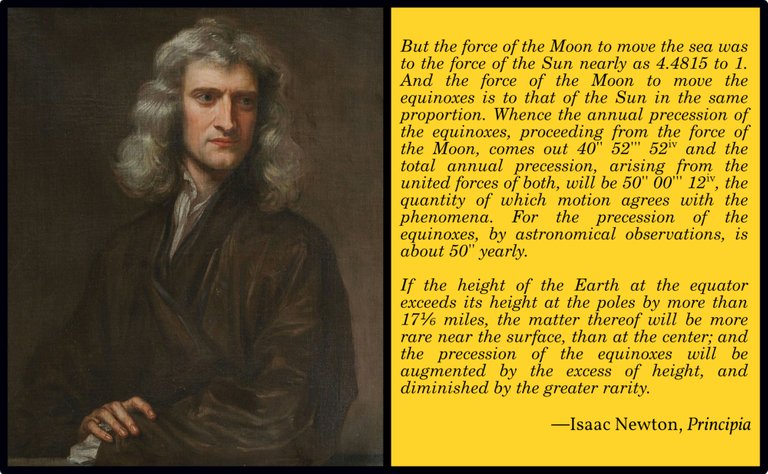
Velikovsky does not cite any sources for his brief discussion of the latter phenomenon:
The earth experiences the precession of the equinoxes, or a large spin of the axis with consequent displacement of the seasons in relation to the perihelion (the point on the orbit closest to the sun). This precession or “preceding” of the vernal and autumnal equinoxes is as great as 50.2" in a year, and the terrestrial axis describes a wide circle in the sky in a period estimated at about 26,000 years. Newton explained this phenomenon, known since the days of Hipparchus (-120), as produced by the attractive effect of the sun and the moon on the bulging part of the equator. But this explanation does not account for what in the first place caused the earth’s bulging part or equator to take the position under an angle to the plane of terrestrial revolution, or ecliptic. (Velikovsky 113)
This was not taken from Brooks, who never mentions Newton or Hipparchus. I have not succeeded in identifying Velikovsky’s source for these details.
Once again, in passing, Velikovsky suggests that the precession of the equinoxes is a relic of a past catastrophe:
This swing of the terrestrial axis—as though the globe were a top disturbed in its motion—could also be caused by a disturbance in the motion of the earth experienced sometime in the past. (Velikovsky 113)
This possibility is rejected by modern astronomers, who accept Isaac Newton’s explanation of the precession of the equinoxes in terms of the gravitational pull of the Sun and the Moon on the Earth’s equatorial bulge. Velikovsky does not actually dispute Newton’s reasoning. Instead, he asks a related question:
But this explanation does not account for what in the first place caused the earth’s bulging part or equator to take the position under an angle to the plane of terrestrial revolution, or ecliptic. (Velikovsky 112)
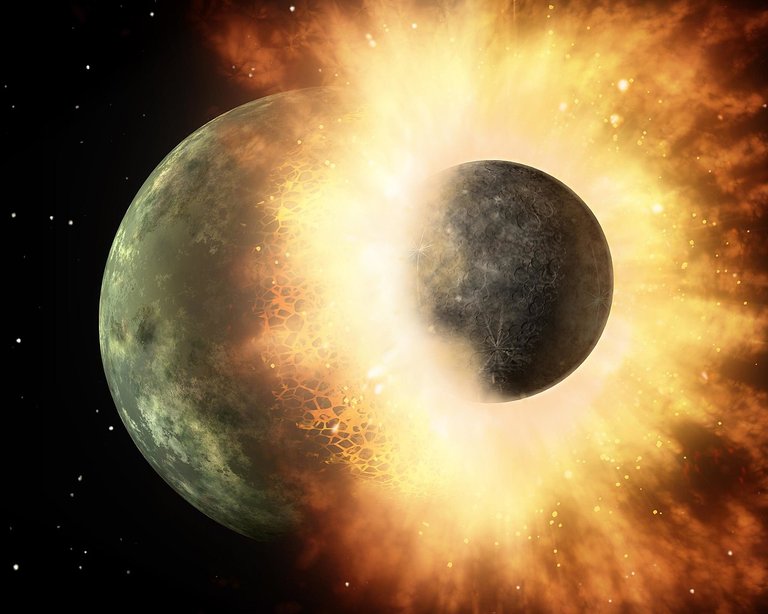
Velikovsky is on firm ground here. Today astronomers concede that at some point in the Earth’s past the planet was struck by a large body, knocking it over. But this catastrophic event is believed to have occurred billions of years ago and to have given rise to our Moon:
But what caused Earth to tilt?
Long, long ago, when Earth was young, it is thought that something big hit Earth and knocked it off-kilter. So instead of rotating with its axis straight up and down, it leans over a bit.
By the way, that big thing that hit Earth is called Theia. It also blasted a big hole in the surface. That big hit sent a huge amount of dust and rubble into orbit. Most scientists think that that rubble, in time, became our Moon. (NASA)
Shifting Poles
Next, Velikovsky briefly alludes to the slow secular shift in the position of the Earth’s poles—true polar wander—which was the subject of the second section of this chapter, Shifting Poles:
Finally, we have already spoken of the wobbling of the terrestrial axis, or its describing a small circle around the geographical pole, or, better, of the wandering of the pole that causes small variations in latitudes, discovered late in the nineteenth century. (Velikovsky 113)

James Croll
Velikovsky next mentions and dismisses a theory of glaciation that was first proposed by the self-taught Scottish scientist James Croll:
A theory that employed the changes in eccentricity of the orbit and the precession of the equinoxes to explain the variations of climate was advanced in 1864 by James Croll, and accepted by Charles Darwin and others; it has since been abandoned, for it requires alternate glacial ages in the Northern and Southern hemispheres, and the evidence contradicts such an order of events. (Velikovsky 113)
Velikovsky first mentioned Croll’s theory in a footnote in Chapter IV, in the section entitled The Birth of the Ice Age Theory, when he described the theory in passing as a theory long since abandoned (Velikovsky 34 fn 6). Croll was also quoted in the present chapter in connection with the shifting poles.
Milankovitch Cycles
Velikovsky concludes this section by refuting the theory of Milankovitch Cycles with some rather obvious objections:
More recently, M. Milankovitch introduced the third variable, the obliquity of the ecliptic, to correct some of the defects of Croll’s theory. In the opinion of his critics, however, his curve of climatic changes widely upsets geological dates; nor do his variables offer sufficiently effective reasons for the vigorous changes of climate. Besides, he assigned an arbitrary length to the oscillation period of obliquity. And why were there no ice ages during long periods in the past, if the process recurs at calculable intervals? (Velikovsky 113)
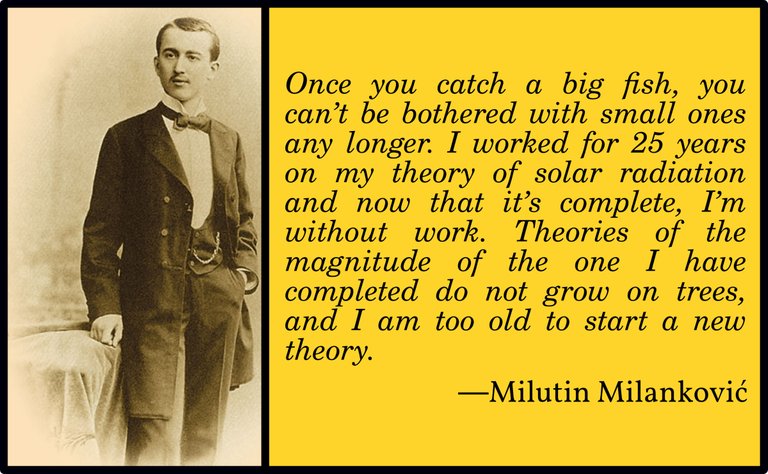
The model of ice ages caused by Milankovitch Cycles fails to save the appearances. In the light of the irreconcilable discrepancies between theory and observation, it is difficult to explain why modern climatologists are still so wedded to Milankovitch’s hypothesis.
Velikovsky closes with a brief postscript, which leads into the final section of this chapter:
Thus the inquiry turned once more to a more radical change—the displacement of the terrestrial crust in relation to the core. (Velikovsky 113)
And that’s a good place to stop.
References
- Charles Ernest Pelham Brooks, Climate through the Ages: A Study of the Climatic Factors and Their Variations, Second Edition, McGraw-Hill Book Company, New York (1949)
- James Croll, On the Change in the Obliquity of the Ecliptic: Its Influence on the Climate of the Polar Regions, and the Level of the Sea, Transactions of the Geological Society of Glasgow, Volume 2, Pages 177-198, Glasgow (1867)
- Milutin Milankovitch, Théorie mathématique des phénomènes thermiques produits par la radiation solaire, Gauthier-Villars et Cie, Paris (1920)
- [Isaac Newton, Andrew Motte (translator)(https://archive.org/details/newtonspmathema00newtrich/page/n7/mode/2up?view=theater), Newton’s Principia: The Mathematical Principles of Natural Philosophia, First American Edition, Carefully Revised and Corrected, Daniel Adee, New York (1846)
- Immanuel Velikovsky, Earth in Upheaval, Pocket Books, Simon & Schuster, New York (1955, 1977)
Image Credits
- Milankovitch Cycles: Adapted from Skeptical Science Graphics (designers), Creative Commons License
- Milutin Milanković: Anonymous Photograph, Public Domain
- Charles Ernest Pelham Brooks: Anonymous Photograph, National Meteorological Library and Archive, Met Office, Public Domain
- Pierre-Simon de Laplace: Jean-Baptiste Paulin Guérin (artist), Palace de Versailles, Public Domain
- Joseph-Louis de Lagrange: Anonymous Portrait, Private Collection, Public Domain
- John Nelson Stockwell: T J J See, Historical Notice of John Nelson Stockwell of Cleveland, Popular Astronomy, Volume 28, Number 10, Plate 24, Goodsell Observatory of Carleton College, Northfield, Minnesota (1920), Public Domain
- Alfred Wilks Drayson: Anonymous Photograph, Morgan Family History Blog, Public Domain
- Isaac Newton: Godfrey Kneller (artist), Isaac Newton Institute for Mathematical Sciences, University of Cambridge, Cambridge, Public Domain
- The Big Splash: Artist’s Impression of a Celestial Body as Big as Our Moon Colliding with a Mercury-Sized Planet in the Star System HD 172555, NASA/JPL-CalTech, Public Domain
- James Croll: Anonymous Photograph, James Campbell Irons, Autobiographical Sketch of James Croll, Edward Stanford, London (1896), Public Domain
- Milutin Milanković on His Life’s Work: Anonymous Photograph, Public Domain

Thanks for your contribution to the STEMsocial community. Feel free to join us on discord to get to know the rest of us!
Please consider delegating to the @stemsocial account (85% of the curation rewards are returned).
You may also include @stemsocial as a beneficiary of the rewards of this post to get a stronger support.